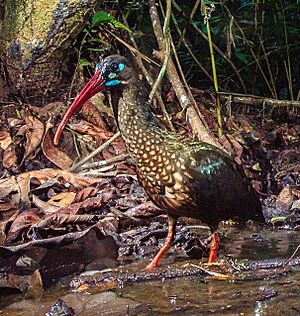Spot-breasted ibis facts for kids
Quick facts for kids Spot-breasted ibis |
|
|---|---|
 |
|
| Photographed by a camera trap in the DRC | |
| Conservation status | |
| Scientific classification |
The spot-breasted ibis (Bostrychia rara) is a small bird. It lives in forests and swampy areas in Africa. These birds prefer thick rainforests in tropical Africa. Because of this, they are hard to spot. They are also affected by deforestation, which means forests are being cut down.
Contents
What Does the Spot-Breasted Ibis Look Like?
The spot-breasted ibis is a small, dark ibis. It is about 47 cm (19 in) tall. It has long legs and a long, red bill. Adult birds have a long, loose crest at the back of their heads. This crest is dark brown to black and looks shiny green.
Their feathers are usually brownish-blue. The upper back is brown with shiny green edges. Their lower back and tail are blue-green. The wings are blue-black. The best way to tell them apart is by the buff-colored spots on their neck, chest, and belly. These spots give the bird its name. They also have turquoise green spots near their eyes.
Young ibises are not as brightly colored. They also have a shorter crest than the adults. When flying, these birds have wide wings and a short tail.
Where Do Spot-Breasted Ibises Live?
The spot-breasted ibis lives in many African countries. These include Angola, Cameroon, and the Democratic Republic of the Congo. They are also found in Ghana, Nigeria, and Uganda. Even though they live in a wide area, they are not common. They are considered a rare bird.
These ibises do not migrate. They live in the same area all year long. Their habitat is in wooded swamps. They also live in forested areas near streams.
How Do Spot-Breasted Ibises Behave?
Spot-breasted ibises are hard to see. This is because they are usually quiet and live alone. If something bothers them, they often fly from the ground. They will land on a nearby branch and stay silent. The best time to find them is at dawn and dusk. This is when they call out while flying.
Sounds They Make
When they are eating on the ground, they are usually quiet. But at dawn and dusk, they call out during flight. They make a loud, harsh sound like "ha-han".
What Do They Eat?
Spot-breasted ibises eat both plants and small animals. They are omnivorous. Their diet includes small crustaceans and insects. They eat grubs, worms, and aquatic snails. They also eat larvae and different kinds of beetles.
They usually eat during the day. But sometimes they will feed at night when the moon is bright. Most of these birds eat alone or in pairs. They use their long bills to search for food. They probe through the mud in swamps. They also search along the banks of forest rivers and streams.
Life Cycle and Reproduction
Spot-breasted ibis nests are often found on tree branches. They are usually one to six meters above the ground or water. These birds nest alone. They usually lay two eggs at a time.
They can reproduce throughout the year. However, they do not lay eggs during long dry seasons. This is when water levels are too low. For example, in Gabon, they laid eggs in most months. The most eggs were laid during the rainy seasons. The eggs hatch in about 20 days. The young birds are ready to be on their own about 40 days after hatching. Baby ibises are born with dark brown fuzz. This fuzz is replaced by thicker white fuzz after about six days.
Protecting the Spot-Breasted Ibis
Like many other birds, the spot-breasted ibis is losing its home. This is due to habitat loss and fragmentation. Deforestation has destroyed much of the dense rainforest they need. Hunters have also harmed this species.
Even with these problems, the spot-breasted ibis is not considered globally threatened. For example, fishermen sometimes take young birds from their nests. But overall, the species is listed as "Least Concern." This means it is not currently in danger of disappearing.


